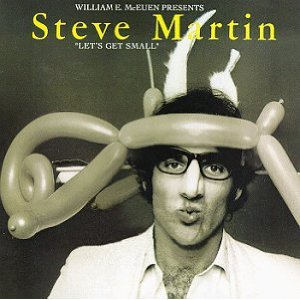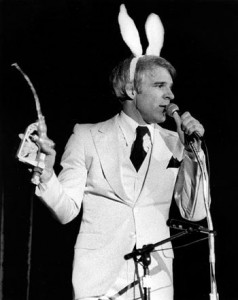Late to the Party: Let’s Get Small and A Wild and Crazy Guy
 When Steve Martin arrived on Twitter last year, I raised an eyebrow—not because I am particularly interested in following celebrities, but because it represented his possible return to a presentational, gag-driven comic mode. Martin ended his stand-up comedy career in the early 1980s, but as Glen Weldon recently suggested, “Twitter is for jokes.” While Martin’s Twitter feed proved not as funny as those of Peter Serafinowicz, Julie Klausner, and Patton Oswalt, his return to joke-telling set me thinking about his rise to fame as a stand-up in the late 1970s. Although my interests in stand-up and the early years of Saturday Night Live should have exposed me to the albums by now, I use “Late to the Party” as an excuse to familiarize myself with Martin’s two Grammy-winning, platinum-certified LPs, 1977’s Let’s Get Small and 1978’s A Wild and Crazy Guy. I have been content to ignore most of his recent work in literature, film, and music, but I was eager to get acquainted with his work at its most comedic.
When Steve Martin arrived on Twitter last year, I raised an eyebrow—not because I am particularly interested in following celebrities, but because it represented his possible return to a presentational, gag-driven comic mode. Martin ended his stand-up comedy career in the early 1980s, but as Glen Weldon recently suggested, “Twitter is for jokes.” While Martin’s Twitter feed proved not as funny as those of Peter Serafinowicz, Julie Klausner, and Patton Oswalt, his return to joke-telling set me thinking about his rise to fame as a stand-up in the late 1970s. Although my interests in stand-up and the early years of Saturday Night Live should have exposed me to the albums by now, I use “Late to the Party” as an excuse to familiarize myself with Martin’s two Grammy-winning, platinum-certified LPs, 1977’s Let’s Get Small and 1978’s A Wild and Crazy Guy. I have been content to ignore most of his recent work in literature, film, and music, but I was eager to get acquainted with his work at its most comedic.
Recorded at the now-defunct Boarding House in San Francisco, Let’s Get Small comprises a meandering collection of gags, one-liners, non-sequiturs and noises that coalesce into a generally endearing portrait of a performer experimenting with his craft. The recording is alternately manic and laid back, moving quickly and capriciously among impressions, physical humor, and nonsense—all punctuated by Martin’s trademark banjo. For the most part, the album is harmless, silly fun, and when Martin lists the extravagances he recently bought himself (an electric dog polisher, a fur sink, and a gasoline-powered turtleneck sweater), part of the joy comes in listening to the comic combine words with such surrealist illogic.
When his act approaches offensive or blue material, it usually doubles back onto an indictment of such comedic crutches. On the fifteen-minute title track, for example, Martin tells the crowd that he does not want to offend anyone in the audience by doing “any of those ‘fag’ jokes.” Then, after discovering that there are only a couple of “fags” in the audience, Martin yells, “These two fruits are walkin’ down the street…!” with an affected and exaggerated sneer. This gag plays with the traditional form of the joke (here, the setup is the punch line, and indeed Martin never finishes the joke) and, more importantly, treads the line between a homophobic joke and a joke about homophobic jokes. This is a tricky move, and as with any such gag, the joke’s butt likely relies on individual interpretation. Still, it exemplifies Martin’s interrogation of comic form and highlights the assumptions audiences and performers make regarding appropriate targets of ridicule. As in the titular gag about using drugs to “get small,” Martin filters zeitgeisty comedy through an absurdist lens, which depending on one’s view either offers an original take on such material or saps it of its urgency and importance.
 Having also never heard Martin’s follow-up album, 1978’s A Wild and Crazy Guy, I was surprised by its abrupt midpoint shift. The front half of the album continues the easygoing nightclub act of Let’s Get Small, but the back half presents an explicit record of Martin’s transition from shambling goofball to comedy superstar. Specifically, the title track segues from performances at The Boarding House to a performance at Red Rocks Amphitheater in front of a massive crowd full of Beatlemania-level energy. While the Red Rocks half is not devoid of funny material, the presence of the stadium-sized audience is somewhat alienating. For example, there is something distinctly creepy about listening to a massive crowd of women screaming in faux-orgiastic delight as Martin, playing his SNL character Yortuk Festrunk, compares his lovemaking capabilities to animals going to the bathroom. Entertaining and confident as it often is, A Wild and Crazy Guy is a deeply ambivalent document. While its split between well-known-Martin and celebrity-Martin is conceptually daring, much of the second half feels like those middling Dana Carvey specials where he performs out-of-context SNL bits. Nevertheless, the two albums highlight Martin’s adeptness at accessing comic forms from the past and pointing the way toward further play with the syntax of humor.
Having also never heard Martin’s follow-up album, 1978’s A Wild and Crazy Guy, I was surprised by its abrupt midpoint shift. The front half of the album continues the easygoing nightclub act of Let’s Get Small, but the back half presents an explicit record of Martin’s transition from shambling goofball to comedy superstar. Specifically, the title track segues from performances at The Boarding House to a performance at Red Rocks Amphitheater in front of a massive crowd full of Beatlemania-level energy. While the Red Rocks half is not devoid of funny material, the presence of the stadium-sized audience is somewhat alienating. For example, there is something distinctly creepy about listening to a massive crowd of women screaming in faux-orgiastic delight as Martin, playing his SNL character Yortuk Festrunk, compares his lovemaking capabilities to animals going to the bathroom. Entertaining and confident as it often is, A Wild and Crazy Guy is a deeply ambivalent document. While its split between well-known-Martin and celebrity-Martin is conceptually daring, much of the second half feels like those middling Dana Carvey specials where he performs out-of-context SNL bits. Nevertheless, the two albums highlight Martin’s adeptness at accessing comic forms from the past and pointing the way toward further play with the syntax of humor.
Historical accounts of American comedy often posit stand-up and sketch from the 1960s and 1970s as anti-establishment (whether the “establishment” in question represents earlier Borscht Belt/Friars Club comedians or the broader social/political milieu). However, Martin’s albums are at once entirely unique and part of a loose collection of comedic practices that resist such characterizations. Often using Saturday Night Live as a home base, comics such as Martin, Andy Kaufman, and Michael O’Donoghue proposed alternative methods of comedic performance that often eschewed direct political satire or traditional gags for absurdist play, experimental performance, and confrontational aggression, respectively. Martin’s act was not as politically urgent or important as those of Lenny Bruce, Richard Pryor, or George Carlin, but it raises the question of where such silliness fits among the often-weighty linchpins of media histories.
With its mundane and amateurish visual/aural design, monologic address, and fourth-wall demolition, stand-up comedy seems to exist at odds with many of the traditional criteria of entertainment media. However, considering the commercial success of Jeff Dunham, Dane Cook, and Chris Rock as well as the critical acclaim of Louis C.K., Hannibal Buress, Eddie Izzard, and Margaret Cho, stand-up remains a significant yet underexplored dimension of media culture. Spreadable, transmedial, and often political, stand-up has much to contribute to our current conversations about media, and it may well point toward future discussions. While I began this brief project curious about Martin’s work and followed it through with considerable enjoyment, I am left with more difficult questions regarding how these recordings and others like them fit into historical narratives and contemporary discussions of media genres, practices, formats, and modes of address.


